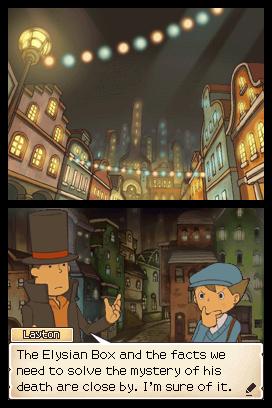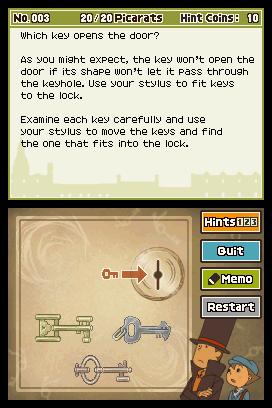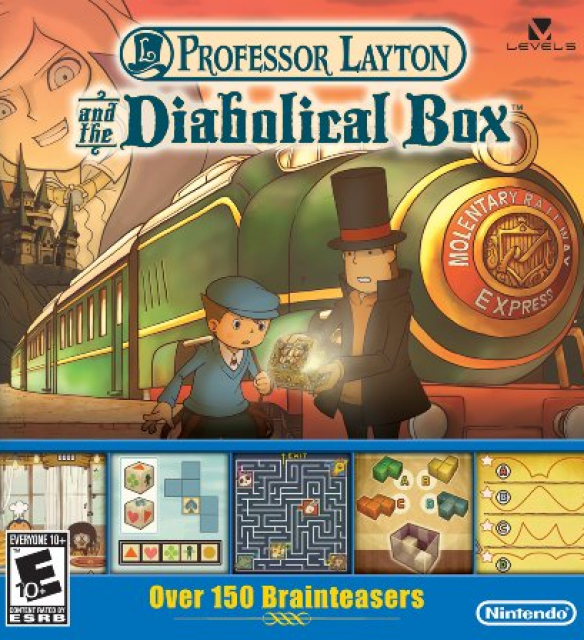More of the same Layton goodness, but not any worse for it
Professor Layton & Pandora’s Box (or the Diabolical Box depending on which region you’re playing the game in) is the second instalment in the DS puzzle-collection franchise. After the death of a friend appears to have been linked to the age-old box, Layton and his young apprentice Luke set out to uncover the mystery behind it by exploring the neighbouring areas and consulting the locals. While Pandora’s Box technically doesn’t do too much to set it apart from its predecessor, for those fans of the original that might not be such a bad thing.
If you’ve played the first game then the formula of Pandora’s Box will be of no surprise to you. Controlling Layton and his young apprentice Luke, you’ll be solving a variety of different brainteasers in order to progress through the point and click-style adventure and solve the over-arching mystery. Puzzles will feel fairly familiar to anyone who has previously picked up a book of brainteasers, and in Pandora’s Box you’ll be required to solve them either to advance the story directly or in return for some useful information from someone to help solve the case.

Puzzles may involve solving a simple riddle to identify the correct object in a picture, sliding tiles around in a block puzzle to rearrange them correctly and simple mathematical puzzles where using complex algebra is rarely the key to finding the answer. There’s a large variety of different brainteasers on offer, and while there are a few puzzles which make repeat showings in a few varying difficulties, there’s just enough different types to keep you on your toes even once you feel you may have mastered one particular riddle type. While the puzzles of the original game generally felt random and unrelated to the situation at hand when posed, Layton 2 does well to keep most of its riddles themed around the case or Layton and Luke’s current situation. Crossing a rickety bridge may initiate a puzzle regarding which steps to take across the bridge’s broken planks. Finding a particular character in a crowd may require you to go through a process of elimination with the character’s known features versus the similar looking characters around him. Usually this works out quite well, aside from a few instances towards the end with some specific puzzles which end up being used three times in a row because they weren’t so relevant at any other point in the game. When the game has fewer than 150 puzzles on offer and you’re forced to go through the same puzzle type three times in a row to advance the plot, it can feel a bit monotonous.
While The Curious Village kept most of its puzzles and plot contained within the same village for the entire game, Pandora’s Box sees Layton and Luke travel to an assortment of locales during the development of the mystery via the Molentary Express. I didn’t mind the change of scenery in the game too much, but the jumping around from place to place did have an adverse effect on the relationship I would build up with some of the characters I met during the adventure. Since the original game stayed within the village for the entire narrative, as a player it was easy to establish a certain fondness to particular characters as their personalities developed over the course of my time with them. Unfortunately, Pandora’s Box loses some of this charm, as many of the characters you’ll meet during your journey won’t be seen again until the credits sequence, which I felt was a bit of a shame.

In between puzzles, the game functions just like your standard point and click adventure. You’ll move between a number of nice looking static backgrounds, sometimes with 2D characters present that you can interact with for a puzzle or a quick chat. Clicking around the backgrounds will sometimes uncover hint coins as well, which can be used to unlock up to three hints for each puzzle. While hint coins were present in this same manner within the first title, I feel that their inclusion could have been improved to the point where finding them didn’t become a matter of incessantly bashing the stylus around the screen. Their use in puzzles wasn’t always as helpful as I would have liked either – while there were a few occasions in both games where buying all three hints to a puzzle would almost blatantly give away the answer, in Pandora’s Box there were several situations where I was in desperate need of a hint to a puzzle and yet the game insisted on giving me useless trivia for my coins instead. When a hint system is implemented for a game and you have to look to an online guide or message board for help instead, you know something’s amiss.
The game does feature a new memo system to be used within puzzles for handwritten notes and calculations which was definitely a plus. Occasionally the size of the touch screen and limit of one colour to draw with would force me to take out a pen and pad anyway, but the system’s inclusion certainly becomes helpful in more than a handful of situations, particularly when tracing routes in mazes or keeping track of simple numbers. Weekly downloadable puzzles also make a return to Pandora’s Box which is great for extending the life of the game past the credits, although they can lack the same charm of the story’s puzzles without the same characters and storyline behind them.
The game features just as much charm as its predecessor in terms of its cartoon visual style and European soundtrack. However, I feel that in a puzzle collection whose ultimate selling point over the free puzzles you may find online is the narrative holding it all together, the actual story telling could definitely be improved. While the DS’s technical limitations may be at fault for some of this, it seemed that in between each of the Japanese anime-style cutscenes and fully voiced dialogue the written dialogue alone wasn’t really witty nor interesting enough to prevent me from mashing the B button so that I could get to the next puzzle. To add to this, many of the more lengthy conversations encountered with characters are summarised quickly afterwards by a pop-up box explaining where Layton and Luke want to go next and why, which makes wading through several boxes of text speech all the more insipid. This wouldn’t be a problem if all dialogue was voiced, as the majority of the voice work in the game is actually rather well done, but it’s clear that such an option would probably be a little too resource-heavy on the DS compared to on a home console.
All things considered, Professor Layton & Pandora’s Box is still an excellent DS title through and through which makes a great addition to handheld collections. If this is your first Layton game, then be aware you may encounter a few minor spoilers regarding the original game’s characters within, so I’d recommend playing the first before starting the sequel. Fans of the original needn’t worry though, as Pandora’s Box is simply an extension of the same great experience with a brand new narrative, every ounce as good as the original.

0 Comments